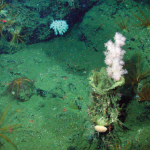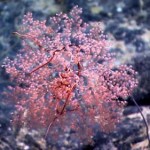This is the fourth in a series of five referenced articles on the shared characteristics of deep and shallow water corals.
 Shallow water corals reefs have been called “the rainforests of the sea” because nooks and crannies created by reef building corals form micro-habitats for other animals, like trees in the rainforest create habitats for beetles and birds. On the coral reef, these niches are home to small mobile species like gobies, gastropods, shrimps, crabs, and seastars; and sessile fauna like bristleworms and sponges. A single 10cm radius colony of Oculina sp. in the shallow Gulf of Mexico can be home to >50 juvenile crabs.
Shallow water corals reefs have been called “the rainforests of the sea” because nooks and crannies created by reef building corals form micro-habitats for other animals, like trees in the rainforest create habitats for beetles and birds. On the coral reef, these niches are home to small mobile species like gobies, gastropods, shrimps, crabs, and seastars; and sessile fauna like bristleworms and sponges. A single 10cm radius colony of Oculina sp. in the shallow Gulf of Mexico can be home to >50 juvenile crabs.
The biodiversity of Lophelia pertusa bioherms in the North Atlantic rivals the diversity of a shallow water tropical reef (Rogers 1999). More than 800 associated species have been documented in association. L. pertusa and Oculina varicosa also provide nursery habitat for redfish Sebastes viviparous (Fossa et al., 2002), gag grouper Mycteroperca microlepsis, and scamp Mycteroperca phenax (Gilmore and Jones, 1992).
Gorgonian colonies are refuge to rockfish (left). Gorgonacea range to 6000m depth, and they are broadly distributed on continental shelves and seamounts wherever suitable substrate exists (Bayer 1956, 1961). So, any human activity that disturbs the seabed can be assumed to destroy anthozoan habitat in one form or another, unless proven otherwise.
This is important, because gorgonians create structural complexity in a relatively featureless environment, deeper than matrix forming scleractinia. They generate habitat for associated species of fish (Heifetz 2002, Etnoyer & Warrenchuk 2007), invertebrates (Krieger & Wing 2002, Buhl-Mortensen and Mortensen 2005), and microbial fauna (Penn et al 2006).
Deep gorgonians generate structure where you might not otherwise expect to find it, and they provide nursery habitat like bioherms do. Large Primnoa reseadeformis colonies have been photographed on the Olympic Coast with gravid dark blotched rockfish hiding in the branches (above). Catsharks in the Pacific Northwest lay their eggs on Plumarella sp., another primnoid type gorgonacean octocoral.
The question remains whether gorgonian habitat is obligate or facultative for the fishes (Auster, 2005). Do the catsharks need gorgonians specifically, or can they lay their eggs anywhere? We’re still not sure. However, there are few choices of substrate in the deep-sea, so coral may provide nursery habitat simply due to a lack of alternatives. Deep corals need protection from non-discriminate fishing gears and wreckless anchoring practices. Too many animals depend on these corals to justify careless destruction.
References:
Auster, P. 2005. Are deep-water corals important habitats for fishes? Pages 747-760 in A. Freiwald and J. M. Roberts, eds. Cold-water corals and ecosystems. Springer-Verlag Berlin Heidelberg.
Bayer, FM (1956) Octocorallia. In: Moore, RC (ed) Treatise on invertebrate paleonotology. Part F, Coelenterata. University of Kansas Press, Lawrence, Kansas, p 166-231
Bayer, FM (1961) The shallow-water Octocorallia of the West Indian region. A manual for marine biologists. Stud Fauna Curacao and other Caribbean Islands 12. Martinus Nijhoff, The Hague
Buhl-Mortensen L, Mortensen, PB (2005) Distribution and diversity of species associated with deep-sea gorgonian corals off Atlantic Canada. In: Freiwald A and Roberts JM (eds) Cold-water Corals and Ecosystems. Springer-Verlag, Heidelberg, p 849-879
Etnoyer P, Warrenchuk J (2007) A catshark nursery in a deep gorgonian field in the Mississippi Canyon, Gulf of Mexico. Bull Mar Sci. 81(3): 553-559.
Fossa, J. H., P. B. Mortensen, and T. M. Furevik. 2002. The deep-water coral Lophelia pertusa in Norwegian waters: distribution and fishery impacts. Hydrobiologia 471: 1-12.
Gilmore, R. G. and R. S. Jones. 1992. Color variation and associated behavior in the epihepheline groupers, Mycteroperca microlepis (Goode and Bean) and M. phenax Jordan Swain. Bull. Mar. Sci. 51: 83-103.
Heifetz, J (2002) Coral in Alaska: distribution, abundance, and species associations. Hydrobiologia 471:19-28
Krieger KJ, Wing BL (2002) Megafauna associations with deepwater corals (Primnoa spp.) in the Gulf of Alaska. Hydrobiologia 471: 82-90
Penn K, Wu D, Eisen JA, Ward N (2005) Characterization of Bacterial Communities Associated with Deep-Sea Corals on Gulf of Alaska Seamounts. App Env Microbiol 72(2): 1680-1683
Rogers, AD. 1999. The biology of Lophelia pertusa (Linnaeus 1758) and other deep-water reef-forming corals and impacts from human activities. International Review of Hydrobiology 84(4):315-406.





